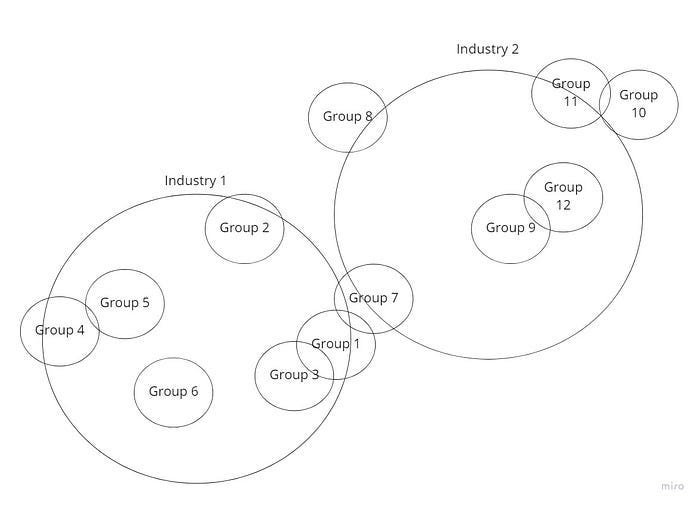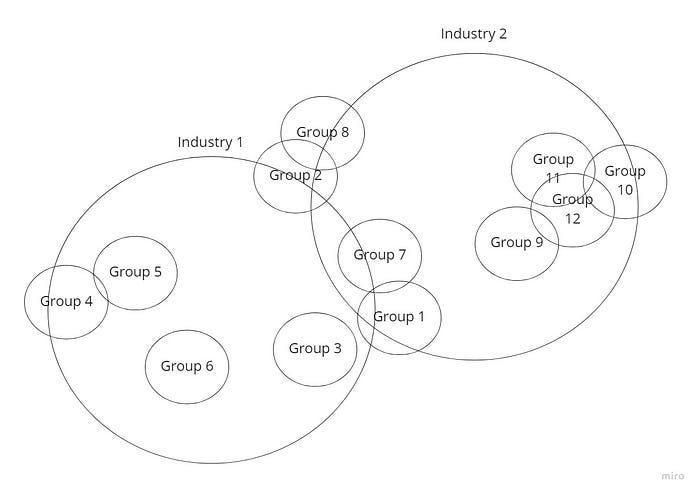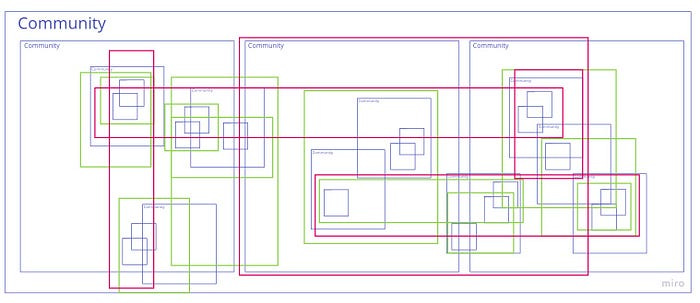(3) Composability Series: Networking in Crypto Communities
Stop trying to approach people on LinkedIn; you need to understand the structure of content, conversation, and community.

Networking is an exciting topic that has changed wildly over the years, especially during Covid-19. It used to mean getting someone’s business card, then in the digital world, that card became represented by a connection or a follow.
We’ve distilled networking down so much that having a point or signifier of contact seems good enough — but that won’t cut it anymore.
Networking is an iterative process where we slowly develop our own approach, but general frameworks make learning the process easier. Think of it like climbing a mountain — there are many paths you can take to the top, but advice about preparation and trail patterns holds no matter the person or mountain.
In an earlier article, I touched on how the crypto space is well aligned and gave some teasers on the diversity and collaboration of communities on Ethereum. It’s not hard to get a few connections on LinkedIn for initial conversations or enter a bunch of discord channels and fire off some broad questions — but then you’ll quickly find yourself as a community ghost.
But before we get to that, let’s start here: Crypto is a space ruled by content, conversations, and communities. You will need to know how to navigate these three aspects in tandem to start making real strides.
Content: everything you read, watch, and listen to
Conversation: engagement on top of or with that content
Communities: all those you engage and build relationships with
It’s challenging to manage and track these three together, especially if you are new to the space. The velocity of change here is rapid, as problems are constantly growing in scope or depth, and the range of experiments tackling those problems grows exponentially by the day (some of which become products).
This means that:
Each of these problems and experiments creates a ton of new content
That content then drives numerous new conversations as people bring attention to, teach about, or critique the problems and/or experiments
Eventually, each problem and/or experiment starts to mature and grow a new community around it.
But it’s tough to map content to conversations and then communities, meaning it becomes a disorganized one-way funnel:
I believe that after a while, most people get stuck in the “Conversations” piece of the funnel.
This is where they only see the most viral conversations or from those they already follow. Limiting exposure to conversation means a lack of exposure to the entire content space, or worse — just ignoring a lot of it. And ultimately, this makes it difficult to explore any communities other than the first two or three they joined. And this is fine; we all end up here at some point. When I first found myself here, I started asking the following questions:
How do I follow the current conversations?
How do I drive new conversations on topics of my interest?
How can I become a more significant part of these communities?
To answer these, you need to understand how and why each piece of content is created. In other words, contextualizing the piece and then understanding how the conversations around it spread across communities. Let’s work up from the earlier funnel framework to this one:
Instead of drawing links connecting the dots in the funnel diagram, this framework attempts to organize those dots in a more flexible, layered manner. This mental framework now becomes a one-way traversable space based on the layer you choose instead of chaotic branching paths.
While this may seem unrelated to networking and making friends, knowing how to sort the crypto landscape into a more organized framework will help you find the communities you actually care about or even create your own.
Where do problems and experiments come from?
Before we get to how problems arise in crypto, let’s step out into the rest of the world. Many startups are born to solve a value chain problem an enterprise giant hasn’t noticed or prioritized. Similarly, people move to and from communities when said community has become too large or doesn’t have the interest to focus and address a new/niche problem. Communities are usually offshoots and combinations of people from more prominent communities. For this to happen, it means that communities are not monolithic and typically have sub-circles/groups within them (usually stratified by background, interest, and/or when they joined).
If you’ve read a bunch of thought leadership reports, I’m sure you’ve seen someone state that the “lines between industries are becoming blurred.” Trying to follow those lines through business and business alone is a fools’ errand. What has happened is that something or someone has brought two communities of people to an overlap — and then the industry moved. Every day, groups move around based on problems created and identified by various micro and macro trends across economics, social, technological, political factors.


Above I’ve simulated when only one event/problem arises, but in reality thousands of problems come up each year. In a more concrete sense, rather than chasing communities individually, you should look for where multiple groups of people might have overlapping problems (or drivers behind those problems). Put another way; you shouldn’t try to figure out how communities overlap right now but instead imagine where they might overlap in the future. Thinking two steps ahead will help you stay ahead of the content and conversations.
Now back to crypto. Here we have localized economic, social, technological, and political factors. These four factors can be remapped to tokenomics, memes, protocol layers, and decentralized governance.
Tokenomics: how tokens are issued/mined in a way that is rewarding and secures the network (i.e., maintaining the long-term interests of all parties).
Memes: Crypto culture is exceptionally meme-driven in the sense that a meme captures an idea, emotion, and image. Memes can then drive the community in certain directions.
Protocol Layers: This is harder to understand if you’re unfamiliar with the space, but refers to the Ethereum/blockchain base layer versus smart contracts or user-facing components.
Decentralized Governance: Implicit trust is a big part of crypto, meaning no one party has an outsize influence to control or change the system (usually referring to any of the protocol layers). Many governance systems exist from DAOs, staking, or incentivized diversity (such as ensuring there is no reliance on a single node provider/package).
From my observation, communities have formed around various combinations of problems that arise from these four factors. There are communities (like Bankless) that are wide and try to cover all problems, and then we have communities (like Flashbots) that go very deep on certain a problem. Here we get to our first big takeaway:
Crypto showcases community-based approaches to identifying and solving issues, instead of delegated approaches (like hiring a team or mandating some organization).
This makes crypto very flexible, and once you wrap your head around that it becomes easier to look at a community and say, “oh, that group is really focused around X problem due to a new issue found in Z factor, and that problem originally arose from within this other community over here that was tackling Y problem.”
With that, we’ve built up to here:
Notice that I’m not trying to map one community to another with nodes and edges. Instead, it’s nodes that overlap and have varied sizes. If you have a math background, you may have noticed a pattern in the chart. These communities have a self-similar structure, essentially representing fractals. I don’t want to geek out too much, but that means we could loosely infer that there will be an infinite number of communities tackling a possibly finite number of problems.
Anyways, the problems are just the beginning. These communities are interested in solving these problems, and that requires experimentation. Experimentation requires an accumulation of ideas and talent. This accumulation requires a way to reach across communities in a standard way: content.
Great I’ve figured out the problem a community is solving, so how do I contextualize a piece of content?
Let’s say I’m a community, and I want to run an experiment with other cool and smart people. Content provides a standard method to convey my complex ideas (rather than conversation, which is kind of like playing telephone). Bad content will convey too much at once, and it loses the context along with the reader.
Content almost always works through three contextual stages:
Learn: this is where we learn about the problem at hand
Build: this is where we learn about possible experiments to tackle the problem
Teach: this is where we convey lessons learned and also how to use whatever solution/tool came out of the experiments.
Learn content is usually long-form articles or research papers. Build typically comes in the form of panels and podcasts. Teach comes in the form of developer docs/tutorial GitHub repos/youtube live streams at hackathons. These types of content act as the community's voice and are often made with the help of another tangential or larger community. For example, Flashbot's content largely bootstrapped off of Eth R&D.
I’ll link a guide to buckets of content (i.e., whitepapers/articles, podcasts, panels) and popular producers of crypto content here later. That’s when I’ll try to paint a clearer picture of the hierarchy of problems in crypto — it’s too long and technical to fit here.
As a reader, you should also think about which stage of content is best suited for you currently — you might not need or want to read all three stages. Remember how the communities (and problems) are interlinked and somewhat hierarchical? This means if you don’t understand the content you are reading, you need to move upwards to the larger problem and read about that first. A good way to do this is to find the communities at whatever level of problem you’re reading about and then ask questions on that community’s Discord or members’ Twitter. Seeing what context of content a community is putting out also tells you what stage they are probably at in tackling the problem (do they understand the problem? do they have concrete ideas on solutions yet? do they have something you can use?).
Now we’re at our second big takeaway:
Content acts as a bridge between communities, usually between levels of a problem space. It also acts as a signal for attracting different types of people, from those who love to scope a problem to those who love to design solutions.

Content doesn’t move or grow by itself, though; it requires a conversation to really extend it past the original community/communities.
Starting a conversation
Yes, conversations themselves are content — but the important distinction here is that these conversations include an endless number of people and have no set agenda. The content I described in this article acts as the initial lighthouse for the conversation. You can then travel and drift in many different directions with various others before coming back.
When you see a new conversation, start by asking, “what content is this conversation about, what is the context of that content, and what communities are involved?” They’re trying to reach someone, figure out who it could be (intended or unintended audience).
Here’s an example I came across just now:
The content (the excel sheet) represents teaching about a topic (staking Ethereum on ETH 2.0) that was affected by a problem from the protocol layer factor (merging to ETH 2.0 + various EIPs) to bring it to communities that exist across other problem spaces (investors, researchers, etc.). Sometimes it won’t be this clear cut and no content will be directly attached to the tweet/post, but a Google search will probably help you find what was being referenced. Adding conversation boundaries to our framework gives us this:
But this has become somewhat of an unnecessary mess, so let’s simplify it:
Conversations are meant to carry ideas and awareness of problems to communities that may not have heard of them yet, then bring fresh input back to the content creator. With this, we get to our third and final takeaway:
When you add to the conversation, think about how you can add a diversity of perspective or bring in another community to the conversation.
But there’s a slight complication here, and that’s platforms. We have a multitude of platforms to hold disjointed conversations on, from Twitter to Reddit to Discord and more. We can all relate to the congestion and overload of pretty much all these platforms. Navigating conversations often feels like driving in circles through a fog.
So how do you follow a conversation when it starts and spans across so many different platforms? For this, let’s separate them into two types of platforms:
Inside the community: Discord, Slack, Telegram; any platform where communities are invite-locked (even if the invite link is public).
Outside the community: Twitter, Reddit; any platform where you can discover and engage across multiple communities at once.
At the end of the day, no one wants empty talk. If you’ve had a good conversation on Twitter with various people (outside the community), take those insights or the thread link itself to a Discord or Telegram channel (inside the community) to drive deeper discussion.
It’s dangerous to go alone! Take this:
That was a lot; let’s get to takeaways of the Fractal Community framework:
Crypto showcases community-based approaches to identifying and solving issues, instead of delegated approaches (like hiring a team or mandating some organization).
Content acts as a bridge between communities, usually between levels of a problem space. It also acts as a signal for attracting different people, from those who love to scope a problem to those who love to design solutions.
When you add to the conversation, consider adding to the diversity of perspectives or bringing in another community to the conversation.
When you follow these steps, you’ll end up networking in a sustainable manner with people that actually interest you (and vice versa). To end it off, I’m going to provide some concrete examples from my own experience of how I use the framework from this article to network and make friends:
Scenario one, what to do with found content: Every time you see content, think about what community the writer was targeting (i.e., who would benefit the most) and then reach out to that community on a platform that allows for the correct style of conversation. A few days ago, I came across a Twitter post showcasing the first loan origination on Ethereum for a mortgage. First, I worked backward through the conversation to find useful content that gave context to the event. I then went to Slack and Discord to share this across channels, where I knew there would be an interest in the legal, financial, or technical aspects of this event (adding my own voiceover to highlight relevant points). I scheduled three follow-up calls with people to discuss these topics further.
Scenario two, when to produce content: If there’s a community of people you want to engage with, then look for another community you might be able to connect them with. If you can’t find the content to start the conversation, go and create it yourself! A few weeks ago, I came across a product called Dune Analytics. Their product allows you to create SQL queries onto Ethereum data directly (which is really cool). Having been in the data science community for a while, I thought it would be perfect to create a few articles that helped my friends in data science learn Ethereum and my friends in Ethereum learn SQL. After creation, take the content and promote that across both communities. I then shared these with the Dune Discord and Twitter communities and across the Towards Data Science community and have since met at least six amazing people to have continued discussion and work with.
Scenario three, how to keep the relationship: This step is easier but often ignored. Take the content you found or created, and find a way to push that to those people directly. Here’s where direct messaging, emails, and LinkedIn actually thrive — both the MakerDAO mortgage origination and my Ethereum SQL articles I sent to the inboxes of ten people (email, text, LinkedIn, etc.). I can’t count the number of fun conversations and questions (or at the very least, appreciation) I’ve gotten from engaging with my existing network in this way. Note that this is different from engaging with your communities, as this is your own network.
I am sure you’ve noticed a trend with these three examples. Networking always involves finding/creating content, using that to drive conversation, and then connecting with the few people you’ve found a spark with to continue the cycle. Eventually, you’ll find yourself spread across the whole range of content, conversations, and communities (both from your efforts and being pulled in by people around you). At that point, “networking” and navigating the cacophony of content and conversations become second nature.
The concepts and Fractal Communities framework I covered today are not limited to networking and making friends in the crypto industry. The problem is while many other industries produce a lot of content (those 80-page reports and slide decks), they don’t really have as many visible conversations or open communities (all locked up inside corporations or behind consortiums). I strongly believe this will also shift over time as communities from crypto spread across traditional industries and the need for a coordinated but decentralized approach to modern problems such as climate change.








